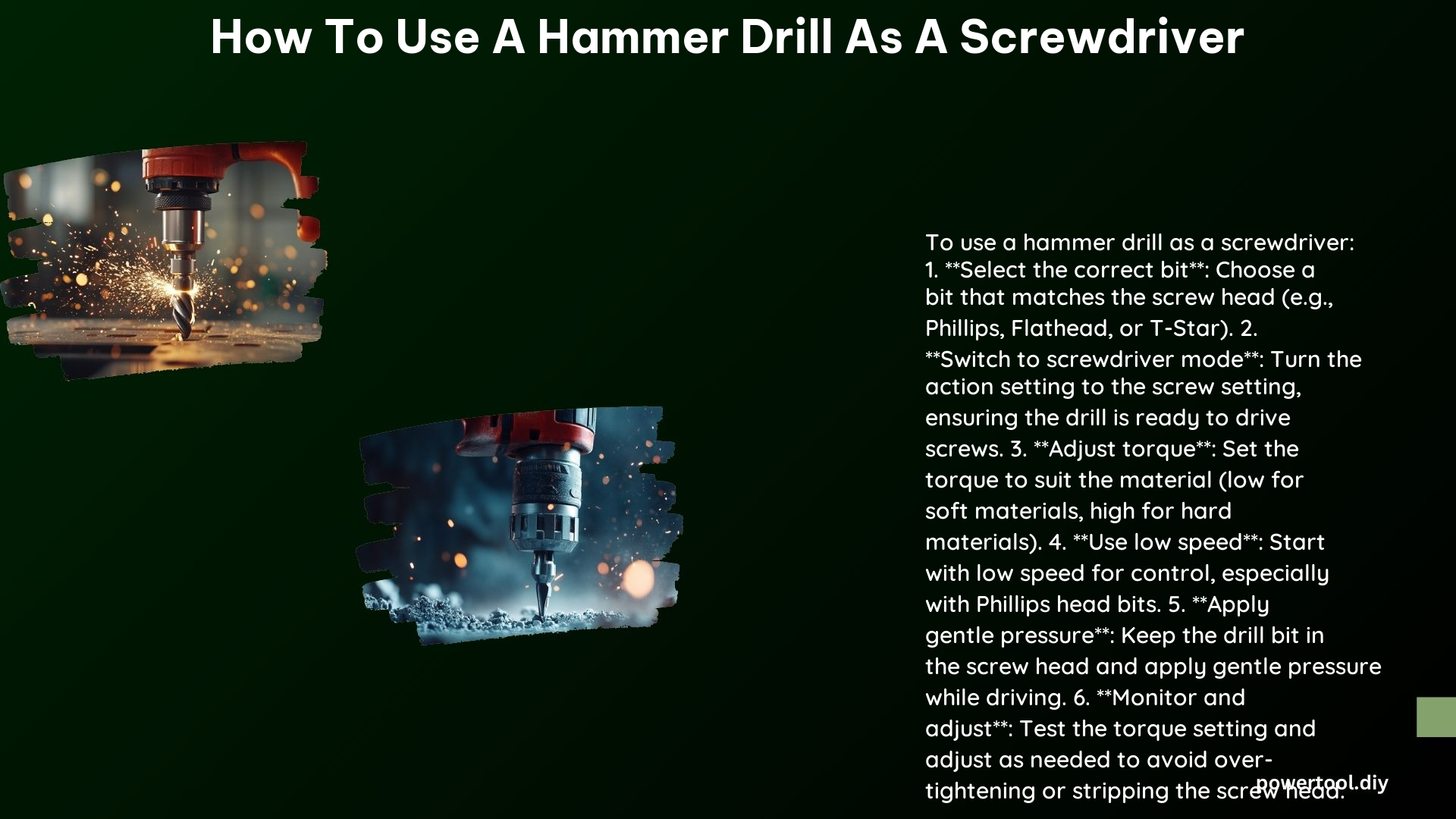Using a hammer drill as a screwdriver is a practical solution when you don’t have a dedicated screwdriver on hand, but it requires careful consideration and adjustments to ensure optimal performance and avoid potential damage. This comprehensive guide will walk you through the key differences between a hammer drill and a screwdriver, the steps to use a hammer drill as a screwdriver, and the technical specifications and additional tips to make the most of this versatile tool.
Key Differences Between a Hammer Drill and a Screwdriver
-
Purpose: Hammer drills are designed for drilling into masonry, concrete, and other hard materials, while screwdrivers are specifically engineered for driving screws into various materials, including wood, metal, and plastic.
-
Hammer Function: Hammer drills feature a hammer mechanism that delivers powerful, rapid impacts to the drill bit, which is essential for drilling into masonry but not necessary for driving screws.
-
Torque and Speed: Hammer drills typically provide higher torque and speed capabilities compared to screwdrivers. This can be beneficial for driving screws, but it also requires careful control to avoid over-tightening or stripping the screw head.
Can a Hammer Drill Be Used as a Screwdriver?

Yes, a hammer drill can be used as a screwdriver, but it is not the ideal tool for the task. To use a hammer drill effectively as a screwdriver, follow these steps:
-
Disable the Hammer Function: Before using the hammer drill as a screwdriver, make sure to turn off the hammer function. This will prevent the unnecessary and potentially damaging impacts that are designed for drilling into masonry.
-
Use the Correct Bit: Select a screwdriver bit that fits the screw head and is designed for the specific material you are working with. This will ensure a secure and stable connection between the bit and the screw, reducing the risk of stripping or damaging the screw head.
-
Adjust Torque and Speed Settings: Hammer drills typically offer a wide range of torque and speed settings. For driving screws, you’ll want to adjust these settings to match the specific requirements of the task. As a general guideline:
- Soft materials (e.g., wood, soft plastics) require lower torque settings (5-8)
- Harder materials (e.g., metal, hardwood) require higher torque settings (13-16)
-
Low speed settings provide more control, especially when using Phillips head bits
-
Practice and Adjust: Driving screws with a hammer drill may take some practice to get the hang of it. Start with a few test screws and adjust the torque and speed settings as needed to achieve the desired result without over-tightening or stripping the screw head.
Technical Specifications
When using a hammer drill as a screwdriver, it’s important to understand the technical specifications and how they can impact the performance and effectiveness of the tool.
Torque Settings
Torque settings on a hammer drill are crucial for driving screws effectively. Typically, you’ll want to use lower torque settings (5-8) for softer materials, such as wood or soft plastics, and higher torque settings (13-16) for harder materials, such as metal or hardwood.
Speed Settings
The speed settings on a hammer drill can also play a significant role in driving screws. Lower speed settings (1-2) provide more control, especially when using Phillips head bits, while higher speed settings (3-4) can be used for faster screw driving in certain applications.
Bit Selection
Choosing the correct bit type for the screw head is essential. Common bit types include Phillips, flathead, and hex. Make sure the bit fits the screw head snugly to prevent stripping or damage.
Additional Tips
To further enhance the performance and safety of using a hammer drill as a screwdriver, consider the following additional tips:
-
Use a Magnetic Bit Holder: Employing a magnetic bit holder can provide a more secure and stable connection between the bit and the hammer drill, reducing the risk of the bit slipping or becoming dislodged during use.
-
Make Pilot Holes: For easier screw driving, especially in harder materials, consider making pilot holes with a small drill bit. This can help guide the screw and prevent it from wandering or becoming misaligned.
-
Countersink Screws: To achieve a flush finish, you can use the hammer drill to countersink the screws into the material. This involves drilling a slightly larger hole to accommodate the screw head, creating a smooth, seamless surface.
Reference
- https://www.youtube.com/watch?v=v3dBc2H7cm4
- https://abutterflyhouse.com/can-drills-be-used-as-screwdrivers/
- https://www.youtube.com/watch?v=WBlYEvQIVrQ
